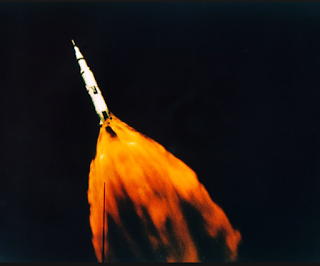Lift-off of the mighty Saturn V rocket assembly from pad 39. NASA.
After the fire disaster of Apollo 1, tests still continued while lessons were learned and changes were made to the Apollo command and service modules. Possibly faulty wiring and systems in the Apollo Block 1 command modules were redesigned to bring newer, better safety factors in line with program directives. There was still a use for the Block 1 command modules though, and the flight of Apollo 4 was one of them.
Stages being assembled in the giant Vehicle Assembly Building, or VAB.
The Apollo 4 mission, also designated as AS-501, was the first mission to start with the Apollo naming protocol. The families and friends of the Apollo 1 fire tragedy had insisted failed test being redesignated as Apollo1. Three other Saturn test flights had occurred before this mission, but had used the Saturn 1b first stage for the unmanned tests. This Apollo 4 mission had been delayed from its original date in 1966, due to the Apollo 1 Stand-down and the delays in re-wiring and re-equipping the newer Block 2 capsules. Thus it was that this mission would use a still-functional, unmanned Apollo Block 1 capsule as a test capsule to record data during the flight.
The fully-fitted Saturn V stack inside the VAB, in one of the four assembly bays. On a humid day, tiny clouds could form at the very top inside the building.
Roll-out of Apollo4 on the giant crawler and tower transporter, slowly moving away from the VAB.
Apollo 4 in place on pad 39A. The crawler has already unlocked and moved away from the launch base.
The Saturn V's first stage heaving the rocket into the upper atmosphere.
Liftoff finally occurred on November 9. This was the first flight of the Stage 1C and S-2 second stage. It was the first time NASA had restarted the S-IV-B third stage. The capsule was placed into a high arc to simulate the returning velocity of capsule coming back from the moon. The capsule safely passed through re-entry, chutes deployed, and it landed in the Pacific ocean not far from the recovery ship USS Bennington. It was a hugely important mission, because it proved that the Saturn V could work, and that the systems were in place to get men to the Moon and back safely before the end of the decade.
Apollo 4 capsule ends its trip in the Pacific Ocean.
Apollo 4 command module next to the USS Bennington before retrieval.
The Apollo 4 capsule is on display at the Stennis Space Center in Mississippi. The hatch is open so that you can see inside.















